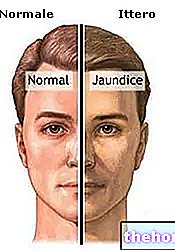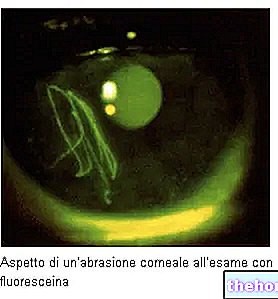Watch the video
- Watch the video on youtube
Choice of eye drops
Eye drops are undoubtedly the first choice drugs for the treatment of conjunctivitis, a disorder that is characterized by inflammation of the conjunctiva. The administration of drugs in the form of eye drops is extremely advantageous because, by instilling the active ingredient directly into the eye, it is possible to speed up the healing time of the disease.

Conjunctivitis
Conjunctivitis is always a symptomatic disease characterized by an "inflammation of the conjunctiva, the thin and delicate mucous membrane that lines the inner surface of the eyelids and the front of the eyeball. As mentioned, before undertaking any topical therapy (with ophthalmic ointments or eye drops) it is essential to recognize the type of conjunctivitis.
The form of conjunctival inflammation is recognized on the basis of signs, symptoms and causes. To facilitate understanding, the table shows the main forms of conjunctivitis, divided according to triggering causes and characteristic symptoms. To complete the analysis, in the diagram In summary, the types of eye drops most suitable for the treatment of the disease are also mentioned.
Type of conjunctivitis
Causes
Symptoms
Eye drops for conjunctivitis
Allergic
Hypersensitivity to materials, drugs, contact lenses, pollen, grasses, dust
- Photophobia
- Hyperemia
- Abundant tearing
- Presence of follicles
- Itching
- Cortisone eye drops
- Antiallergic eye drops
- Decongestant eye drops
Spring
Allergies to pollen and grasses
- Photophobia
- Hyperemia
- Abundant tearing
- Presence of follicles
- Ocular mucous secretion
- Cortisone eye drops
- Antiallergic eye drops
- Decongestant eye drops
- Sun lenses with UV filters are recommended
Viral
Virus-borne infection:
- Adenovirus
- Herpes Simplex
- Eye redness
- Burning in the eyes
- Ache
- Marked photophobia
- Enlargement of the preauricular and submandibular lymph nodes
- Hyperemia
- Abundant tearing
- Watery secretion
- Antiviral eye drops
- DO NOT use cortisone eye drops (unless otherwise indicated by your doctor)
- Analgesic eye drops (when needed)
Bacterial
Infection sustained by:
- Staphylococcus
- Streptococcus
- Haemophilus
- Pneumococcus
- Edema of the eyelids
- Hyperemia
- Lacrimation not particularly abundant
- Itching and burning
- Yellowish, thick and purulent tear discharge
- Broad spectrum antibiotic eye drops or specific eye drops for the triggering bacterium (in case of isolation of the microbial agent)
- Analgesic eye drops (when needed)
Allergic conjunctivitis
The eye drops for allergic / spring conjunctivitis are prepared with antihistamines, decongestants and cortisone, essential for symptom control.
ANTIHISTAMIN EYE DROPS
Although there are no drugs capable of cure allergic conjunctivitis, antihistamine eye drops can undoubtedly improve the clinical picture of the patient or, when used before the arrival of spring, prevent the onset of allergy (be it allergic rhinitis, pollinosis or hay fever).
Having a seasonal incidence, pollen and grass allergic conjunctivitis recurs promptly in spring; for this reason, it is advisable to undertake prophylactic therapy already during the first weeks of March through the moderate and regular application of antihistamine eye drops.
The most suitable antihistamine eye drops for allergic conjunctivitis are prepared with active ingredients such as Sodium Chromoglycate, Nedocromil, Levocabastine and Olopatadine.
Deepening
Antihistamine eye drops work by blocking the action of histamine, a powerful chemical mediator involved in allergic and inflammatory phenomena. By doing so, antihistamines prevent or relieve the symptoms of the allergic reaction.
Below we report the formulation of an eye drop indicated in the Prophylaxis of eye diseases on an allergic basis.
- solution in bottle: active ingredient: Sodium nedocromil mg 100/5 ml; Excipients: Benzalkonium chloride; disodium edetate; sodium chloride; purified water. Dosage: One drop per eye 2-4 times a day. Treatment should not exceed 8 weeks.
DECONGESTANT / VASOCONSTRICTING EYE DROPS
To speed up the recovery, allergic conjunctivitis can also be treated through the instillation in the eye of eye drops that can induce a narrowing of the blood vessels of the conjunctiva. The most suitable active ingredients are Naphazoline, Tonzilamina hydrochloride and Tetrizoline: these are powerful vasoconstrictors capable of removing the characteristic symptoms of allergy (lacrimation, redness, swelling) in a relatively short time.
It is recommended to respect the instructions provided by the doctor and the posology (dosage): excessive use of these drugs more paradoxically cause the opposite effect, thus ending up worsening the symptoms of congestion.
Please note
Eye drops that act as potent local vasoconstrictors, while having poor systemic absorption, should be used with extreme caution in patients with hyperthyroidism, hypertension, diabetes and heart disease. Always consult your doctor before instilling any type of eye drops in the eye.
CORTISON EYE DROPS
Corticosteroid eye drops are often prescribed by the doctor as a support to antihistamine therapy: this is because the active corticosteroid ingredients, while not acting in any way on the triggering cause, are able to determine a powerful anti-inflammatory effect, relieving symptoms such as swelling and redness over a short period. Cortisone eye drops can be formulated with Cortisone, Triamcinolone, Dexamethasone, Hydrocortisone etc .: the choice of eye drops for conjunctivitis severe allergy must be delegated to the doctor It is recommended once again not to undertake the do-it-yourself therapy without first consulting the opinion of an expert.
In the presence of a particularly aggressive form of allergic conjunctivitis, a double therapy is conceivable, consisting in the concomitant use of eye drops (topical application) and tablets to be taken orally (by mouth).
Bacterial conjunctivitis
Complicated and infectious conjunctivitis with bacterial etiology require a more powerful treatment: in this case, the most suitable eye drops are enriched with antibiotic active ingredients, essential for killing the responsible bacterium and avoiding its replication.
To speed up healing and alleviate the symptoms that accompany an "ophthalmic infection (itching, redness, discomfort, abundant lacrimation) it is recommended to support antibiotic treatment with a topical painkiller and anti-inflammatory treatment: for this purpose, analgesic eye drops formulated with NSAIDs can be of help.
When the symptoms of "eye infection" take on a particularly ferocious connotation, the common analgesic eye drops can be replaced by ophthalmic ointments or cortisone eye drops, with a more powerful anti-inflammatory action.
Not surprisingly, eye drops for infectious conjunctivitis are available on the market consisting of a mixture of active antibiotics and steroids.
Eye drops or ophthalmic ointment?
For the treatment of bacterial conjunctivitis, many doctors prescribe antibiotic ophthalmic ointments rather than eye drops: this is because the ointments allow the active ingredient to remain in contact with the conjunctiva for longer periods than simple eye drops. However, ointment formulations have the disadvantage of creating transient blurring of vision. For this reason, we recommend the use of eye drops during the day and an ophthalmic ointment at night, to be applied before going to bed.
MEDICINAL SPECIALTIES
For the treatment of aggressive forms of bacterial infectious conjunctivitis, some dual action eye drops are available, prepared with antibiotics and corticosteroids.
For example, the specialty medicine Mixotone is an eye drop consisting of hydrocortisone (corticosteroid drug) and two antibiotics (neomycin and polymyxin B). Pre-G is also a combined ophthalmic ointment, specifically indicated for the treatment of bacterial conjunctivitis: this drug consists of gentamicin (antibiotic) and prednisolone (corticosteroid drug).
Viral conjunctivitis
Unlike the bacterial variant, viral conjunctivitis begins with less conspicuous but, no less serious, symptoms. The therapy consists in the topical application of antiviral and anti-inflammatory eye drops.
- Sometimes, viral infections of the conjunctiva manifest themselves so lightly that they spontaneously regress; for this reason, the doctor does not always prescribe topical therapy with specific eye drops.
More often, the symptoms of viral conjunctivitis can be controlled by administering analgesic eye drops (formulated with NSAIDs such as Diclofenac or Ketorolac). The topical application of cortisone eye drops for the treatment of viral conjunctivitis is not always recommended: such a treatment could in fact cause serious damage to the eye. Therefore, unless otherwise indicated by the doctor, in the context of viral conjunctivitis it is recommended not to instill cortisone eye drops in the eye and to prefer those formulated with simple NSAIDs.
In case of viral conjunctivitis, it is recommended to strictly follow the hygiene rules to avoid the spread of the infection.
Other articles on "Eye drops conjunctivitis"
- Types of Eye Drops
- Eye drops




























